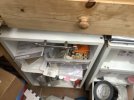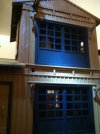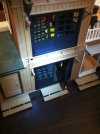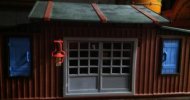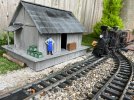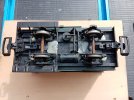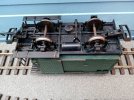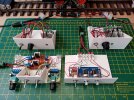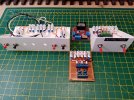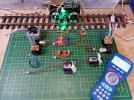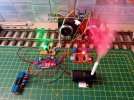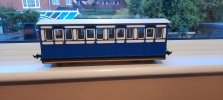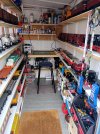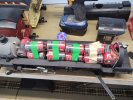Pressing on with wagon-fiddling as a break from loco-worrying, for a week or so I have been mostly painting and tinkering with brakesman's shelters. My freelance Spanish layout is all about impression rather than strict historical accuracy and I wanted to have a recognisable example of each of the four basic designs employed there. Since every line, and RENFE, came up with their own ideas, I could be inventive, using whatever materials I had to hand, much like reality on small lines. This montage shows what I have been trying to emulate:
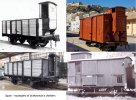
What do you get when you cut into two halves, an Aristocraft Sierra coach door, and graft them into a GRS brakevan with a load of foamboard and plasticard offcuts? A more or less passable version of the Olot-Girona baggage vans topped by their distinctive cupolas, with sliding windows. I hope. Needed some plant plug containers to form central buffers, too. Although the GRS model's strapping prevented my reproducing the low level grilled windows, provided for the comfort of poultry and small animals travelling as baggage, it does attempt to replicate the unusual small tail lamps of the original wagon, with red 2mm tower LEDs fitted perpendicular into custom housings, powered by 2xAA rechargeables - I was actually rather chuffed with how they turned out. The bits box is my best friend - you get my drift.
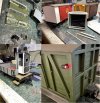
Time to pose the results of my labours. Below, left to right - said luggage van in green as yet unweathered, next to the grey lop-sided cabin prevalent on the Ferrocarril de La Robla, which was a test for fat fingers to create out of myriad tiny bits of plastic. Then comes the standard ridged-roof style enclosed box favoured by the national railway (an early attempt, partly in balsa); and finally, the primitive arched sort, found all over Spain, especially in Catalonia and on mineral/flat wagons (interesting to form the hollow roof arch frame by melting square ABS rod over my largest masonry drill bit - not often I get toxic naked flame at the bench though I only had a 15mm rather than the 18/19mm bit it properly needed). The removable rock load is horticultural grit bound in dilute PVA on a lightweight plastic former.
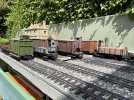
Even though my railway is supposedly standardised with vacuum brakes, wagons with shelters would still have been used for their intended purpose on occasion, and make for more interesting train formations.
In the background, an assortment of LGB and Newquida stuff, mostly obtained in bright orange, red and yellow, recently repainted into more appropriate careworn liveries. I have a limited supply of metal wheels, so save them mainly for the vans and coaching stock. One or two missing hoses and decals to add - I am putting together a stock database, and allocating fleet numbers, with a view one day to trying proper operating - participating in regular sessions on JonD's remarkable railway has been my firing my imagination again.
OK, I'm wagonned out for a while, and now I've had a delivery of electrical components, it's back to loco bashing.
